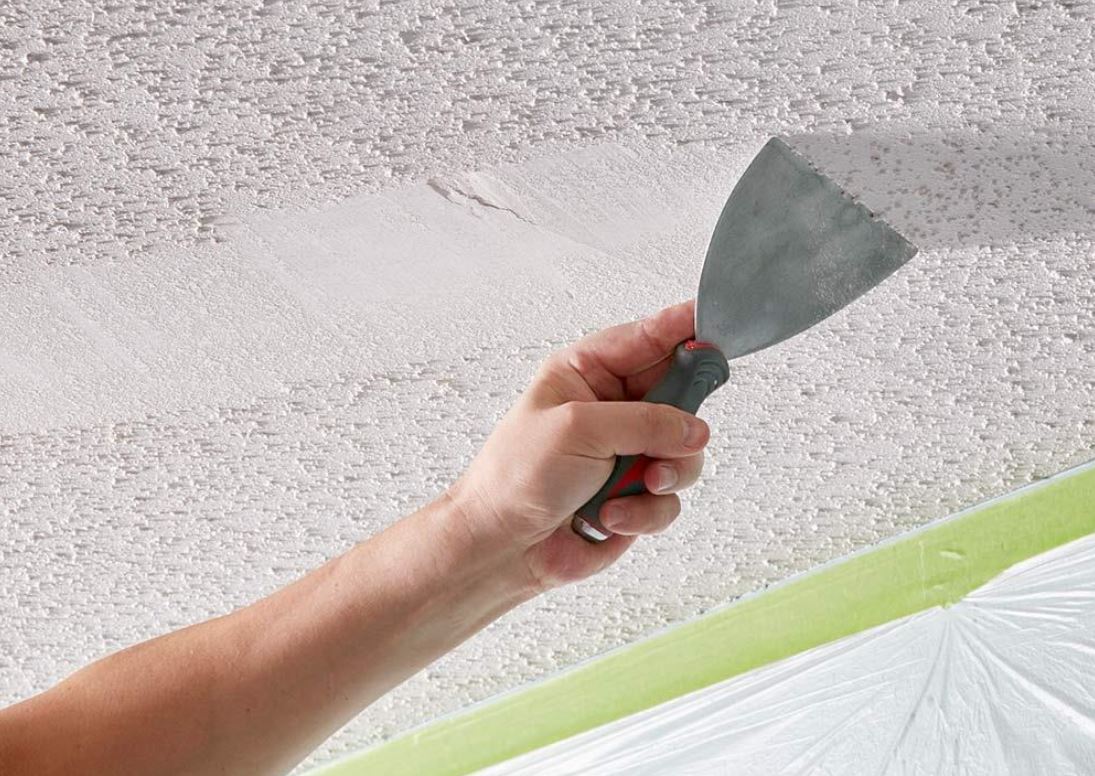Popcorn Removal Made Simple
If there are not any metal rods sticking out of the top of the ceiling, then detach it by loosening all the nuts and bolts on the ceiling. You can use a butter knife to safely remove the nuts and bolts without damaging any fixtures on the ceiling. Once the nuts and bolts are removed, then remove the metal clips that are holding the corn down in place. Take all of the metal clips off so that you can safely
remove the
popcorn. You should be careful when removing them since they can break and cause damage to your ceilings or drywall if you drop them while you are removing them.
It is important to remove all of the metal clips before removing the corns without damaging the corns or the roof. You should never try to fix the corns when they are still attached to the
ceiling repair. This can lead to leaks that can cause more damage. It is important to check on the corn regularly to make sure that it is not growing back.

Removal & Repair
After you remove all of the corns from the roof and the corns have been properly popped, you should now be able to safely remove them. You should remove each in small sections. You should use the corn as leverage to lift each piece of corns off of the roof and out of the house. You will need a ladder to get this done safely. You should first place each corn in an empty plastic soda bottle. This way, you will know how much of the corns to remove and how much you need to remove. Before placing the corns on the ground, cover each one in some grass seed. This way, the grass seeds will keep the pop up corns from covering the corn and making it hard to remove. Pop up corns can be a hazard if they are left on roofs for a long period of time.
You should then slowly move each corn onto the ground. Make sure that the corns are touching the ground. You should then gently tap the corns gently on the celling. This precaution is done just incase their is asbestos resting above the drywall sheets. If the corns do not budge, you should place a broom handle under the corns or use some kind of weight to push them down. You should continue tapping the corns until they are all in line with the roof line. Once you have removed every corn on the roof, you should make sure that you are not walking over any of the corns. You should also be careful that none of the corn gets onto your shoes. These tips will help you remove popcorn safely from roofs, helping you enjoy your summer time.
What are the dangers of Asbestos? Asbestos is a mineral that was widely used during the 1970s because it is resistant to heat and fire. It is resistant to electricity as well. Asbestos was used in thousands of products including ceiling tiles, pipe insulation, paints, fireproofing, flooring, roofing, and drywall. Asbestos was also used in products that we use every day; such as vacuum cleaners, brake pads, and brake linings. If you have one of these products that contain Asbestos, you should know about the dangers of Asbestos removal.
When Asbestos was discovered, the world's media was all a buzz about it. In fact, Asbestos was used so widely that the U.S government banned the Asbestos manufacturing material. The ban was meant to protect American workers from Asbestos-related illnesses. Asbestos is flammable and easily ignitable.
If you have a room in your home that has Asbestos in it, there is a good chance that you have been exposed to Asbestos. If you believe that you may have been exposed to Asbestos, you should take measures to clean the area and get it treated. If you do not have treatment in place, Asbestos can irritate the lining of the lungs and cause cancer. Asbestos is a known carcinogen. This means that it can cause cancer up to 40 years after you are exposed to it.
Asbestos Hazards
Here are some Asbestos Hazards. Asbestos is flammable, and it is even more flammable when it is wet. Any Asbestos materials that are exposed to water are especially at risk for being ignitable. The Asbestos materials that are exposed to the most water are ceiling tiles, drywall, and paint. If an Asbestos material is not properly removed or protected, it can become airborne and then be breathed in by people in the home. A lot of homes contain Asbestos materials. If there is Asbestos in your home, there is a very good chance that someone inside your home has Asbestos in their house. You do not have to worry about contracting Asbestos related diseases from working in your home or from living in your home. However, there are some things that you need to do to make sure that you do not become sick from Asbestos. If you are exposed to Asbestos while at work, you need to tell your boss and get tested for Asbestos.
Mold
Mold also poses Asbestos Hazards. Asbestos is flammable, so it is also dangerous to people who are working with it and to those who are around them.
Asbestos removal is difficult, because once Asbestos becomes disturbed, it releases Asbestos gas. If you are exposed to Asbestos gas, you could become ill from the Asbestos poisoning. It is also not uncommon for people to become ill from mold problems. If you have mold problems in your home or your bathroom, you need to hire a competent professional to remove Asbestos and mold problems from your home.
20% OFF THE PAINT JOB WHEN WE INSTALL 10 SHEETS OR MORE!
Asbestos Poisoning
You can be ill from Asbestos poisoning just by being in your home for a few minutes. It is possible to become ill from Asbestos if you spend time in your home after you have been exposed to Asbestos. Asbestos easily gets into the air. Once inhaled, Asbestos gas can cause a number of health problems. There are a number of different symptoms, which may alert you to Asbestos exposure, such as, shortness of breath, chest pains, nausea, and stomachaches. Asbestos Hazards are not the only Asbestos related problems. You should also be aware of the many health risks, which are caused by Asbestos related materials, including lung cancer, pleural plaques, and mesothelioma, which is a cancer of the lungs. If you have been exposed to Asbestos, you should immediately notify your doctor or your lawyer so they can begin planning for Asbestos removal. Also, the doctor will be able to tell you what type of Asbestos removal is required for your specific situation.
How We Do Popcorn Ceiling Installation, Removal & Repair
At Keller Texas Drywall Contractor, we specialize in popcorn ceiling installation, removal, and repair, ensuring a smooth and professional finish every time. Our team of experienced general contractors handles every step of the process meticulously, whether it's for a kitchen, bedroom, bathroom, or any other room in your house.
Popcorn Ceiling Installation
Installing a popcorn ceiling involves several key steps to achieve the desired texture and appearance. Here's how we do it:
- Preparation: We start by covering all furniture, floors, and other surfaces with plastic sheeting to protect them from dust and debris. Proper preparation is crucial to prevent damage to your property.
- Surface Preparation: The ceiling surface is cleaned and primed. If necessary, joint compound and mud are applied to smooth out any imperfections.
- Application: Using specialized spray equipment, we apply a mixture of stucco and plaster to create the distinctive popcorn texture. This mixture is carefully prepared to ensure consistency and adhesion.
- Drying and Painting: Once the popcorn ceiling is applied, it is left to dry. After drying, we offer painting services to give your ceiling a fresh, uniform look. Our team can also assist with cabinet painting and other home improvement projects to enhance your living space.
Popcorn Ceiling Removal
Removing a popcorn ceiling can be a messy and labor-intensive task, but our professional team makes it look easy. Here’s how we handle it:
- Preparation: As with installation, we begin by protecting your furniture, floors, and walls with plastic sheeting. This minimizes dust and debris spread, ensuring a cleaner process.
- Testing and Safety Measures: Before removal, we test for asbestos to ensure safety. If asbestos is found, our certified asbestos abatement team takes over to handle the hazardous material properly.
- Wet Removal: We use water to soften the popcorn texture, making it easier to scrape off. This method also reduces dust and air pollution, protecting your health and minimizing the mess.
- Scraping and Smoothing: The softened texture is carefully scraped off, and the ceiling is smoothed out using joint compound and mud to prepare it for a fresh finish.
- Final Touches: After the ceiling is smooth and clean, we can repaint it or apply a different texture, such as orange peel, based on your preference.
Popcorn Ceiling Repair
Whether due to water damage, cracks, or other issues, popcorn ceilings sometimes need repair. Here's our approach:
- Assessment: We begin with a thorough assessment of the damage, including checking for underlying issues like mold or structural problems.
- Preparation: As always, we protect your home by covering furniture and floors. This includes areas like the kitchen and bathroom, where moisture might be a concern.
- Repair: Damaged sections of the popcorn ceiling are carefully removed and replaced. We use joint compound and mud to ensure a seamless repair that blends with the existing texture.
- Finishing: The repaired area is left to dry, then painted to match the surrounding ceiling. This ensures a uniform look and extends the lifespan of your ceiling.
At Keller Texas Drywall Contractor, we provide free quotes for all our services, including popcorn ceiling removal in Austin, Houston, and surrounding areas. Our commitment to quality and customer satisfaction is backed by a warranty on our work, giving you peace of mind. For more details on our services and expert advice, be sure to check out
our blog. If you have any questions or need a quote, please don't hesitate to
contact us today!
Frequently Asked Questions
What are popcorn ceilings?
Popcorn ceilings are a textured ceiling finish that was popular in older homes, known for its bumpy, stippled appearance.
Can popcorn ceilings be removed?
Yes, our team specializes in safe and efficient popcorn ceiling removal, providing a smoother, more modern finish.
How long does it take to remove popcorn ceilings?
Removal typically takes 1-2 days, depending on the size of the room.
Can I paint over popcorn ceilings?
While it's possible to paint over them, removing the texture provides a cleaner look and allows for better interior painting.
Are popcorn ceilings harmful?
Some older popcorn ceilings may contain asbestos. We ensure safe removal and disposal according to industry standards.
What Our Customers Think
-
Jane & Kyle
Button“A friend of mine recommended that I call Keller Drywall Contractors of Keller TX and I must say that working with them has been a very smooth and easy process. I spoke the foreman Tom on the phone, we set an appointment, he came out for the estimate then knocked out the job right after that. Thank you so much guys!"
- Keller, TX
-
Jordan Banner
Button“I had a huge hole in my ceiling from the previous plumbing contractor that stepped in the wrong place upstairs, Keller Drywall was able to come out pretty quick and fix the ceiling..."
- Westlake , TX
-
Gordan Brauner
ButtonBeing a construction contractor I always have a lot going on, so when I call Keller Drywall Contractors of Keller, TX for a sub-contracting job I know that they will come out and do exactly what me and the customer needs. There aren't many crews and companies these days that have the skills and precision as yall
- Keller, TX




